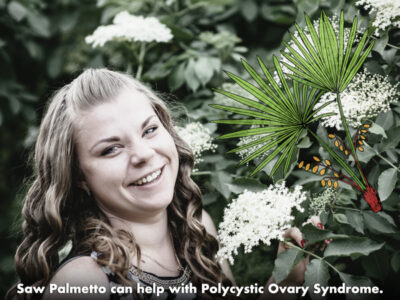For PCOS, saw palmetto is a powerful adaptogenic herb which stabilizes women’s testosterone levels and can thus ease polycystic ovarian symptoms. Adaptogenic herbs like saw palmetto have the unique ability to “adapt” their function according to the body’s specific needs, either enhancing or calming physiological activity. Polycystic ovarian syndrome (PCOS) disrupts a woman’s endocrine system and levels of the hormone testosterone may be increased. Saw palmetto helps to decrease symptoms of hyperandrogenism, or elevated testosterone levels, by inhibiting the enzyme 5-alpha-reductase, and thus helping to stabilize women’s endocrine systems.
 Some of the common symptoms of PCOS including menstrual disturbances, acne, thinning scalp hair along with excess facial and body hair, can benefit from saw palmetto as it binds to excess testosterone and helps to evenly distribute and optimize estrogen.
Some of the common symptoms of PCOS including menstrual disturbances, acne, thinning scalp hair along with excess facial and body hair, can benefit from saw palmetto as it binds to excess testosterone and helps to evenly distribute and optimize estrogen.
Testosterone plays a key role in women’s health: it helps improve muscle mass, enhances female libido, and balances body fat with proper signals in the HPA axis or hypothalamic pituitary axis. However, an imbalance between testosterone and female hormones including estrogens can exacerbate the symptoms of PCOS including acne, insulin resistance, male-pattern hair growth, and hair loss.
PCOS women tend to release higher amounts of cortisol, and as cortisol rises so do adrenal androgens including testosterone. Adaptogens can specifically target the brain hypothalamus, pituitary and adrenal system to heal the body’s fight-or-flight stress response which destabilizes hormones. Chronic stress–whether physical, emotional, mental or environmental–pushes the hypothalamus-adrenal axis, leading to excessive stress hormone output and then hormonal dysfunction.
Saw palmetto, also known as the American dwarf palm tree, is a tree native to the West Indies and the southeast coast of North America. It grows to a height of six to ten feet and is characterized by thorn-shaped leaves that are arranged like a fan. The berries, which are maroon colored and oblong shaped, are used for medicinal applications. Saw palmetto extract is a highly effective anti-androgen, due to the phytosterols it contains. It is now one of the most widely used botanicals in the world.
Saw palmetto is also thought to block conversion of testosterone into the more aggressive breakdown metabolite dihydrotestosterone (DHT). Lowering DHT helps ease acne and menstrual irregularities. Saw palmetto can also decrease the binding of DHT to androgenetic receptors, and reduce DHT uptake by hair follicle which may help with hair loss.1
In our clinic, we see that ample doses of saw palmetto help women with PCOS to reduce acne, help with scalp hair loss, reduce excess body hair, and at times stabilize hormone levels and support regular menstrual cycles. We prefer a saw palmetto berry extract that is standardized for its sterol content, the required high amount used in successful clinical studies to reduce total and free testosterone levels. Other botanicals that can enhance the hormone balancing actions of saw palmetto include: Stinging Nettle, (Urtica dioica) Root Extract, which modulates androgen receptors and inhibits enzymes to effectively treat symptoms of excess testosterone. A dose of 160-240mg, standardized to 15% total sterols, is helpful for PCOS. Pygeum (Prunus africana) Bark Extract which has hormone-balancing effects and also inhibits 5-alpha reductase, so that less DHT is made in the body. A dose of 300-650mg, standardized to at least 15% total sterols is often effective. Pollen concentrate which has powerful anti-inflammatory benefits.
Recommendation: Saw Palmetto (Serenoa serrulata) Berry Extract 320mg standardized to at least 45% total sterols, or 160mg at 85-90%. Take once or twice daily, best between meals, or as directed by your healthcare provider.
References
- Murugusundram S. Serenoa Repens: Does It have Any Role in the Management of Androgenetic Alopecia? Journal of Cutaneous and Aesthetic Surgery. 2009;2(1):31-32.
- Arezoo Moinin Jazani et al. Herbal medicine for oligomenorrhea and amenorrhea: a systematic review of ancient and conventional medicine. Biomed Res Int. Epub date 2018 Mar 18.
- Azziz R. Polycystic Ovary Syndrome. Obstet Gynecol. 2018 Jul 10.
- Grant P and Ramasamy S. An Update on Plant Derived Anti-Androgens. Int J Endocrinol Metab. 2012 Spring 10(2): 497-502.
- Teede HJ et al. Recommendations from the international evidence-based guideline for the assessment and management of polycystic ovary syndrome. Clin Endocrinol. 2018 Jul 19.